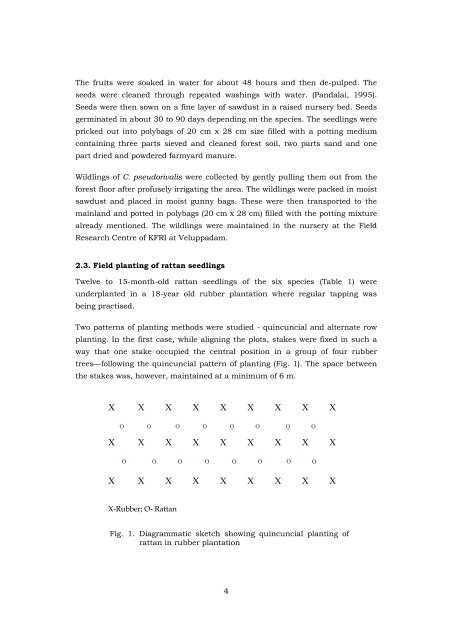underplanting rattan in rubber planttions - Kerala Forest Research ...
underplanting rattan in rubber planttions - Kerala Forest Research ...
underplanting rattan in rubber planttions - Kerala Forest Research ...
Create successful ePaper yourself
Turn your PDF publications into a flip-book with our unique Google optimized e-Paper software.
The fruits were soaked <strong>in</strong> water for about 48 hours and then de-pulped. Theseeds were cleaned through repeated wash<strong>in</strong>gs with water. (Pandalai, 1995).Seeds were then sown on a f<strong>in</strong>e layer of sawdust <strong>in</strong> a raised nursery bed. Seedsgerm<strong>in</strong>ated <strong>in</strong> about 30 to 90 days depend<strong>in</strong>g on the species. The seedl<strong>in</strong>gs werepricked out <strong>in</strong>to polybags of 20 cm x 28 cm size filled with a pott<strong>in</strong>g mediumconta<strong>in</strong><strong>in</strong>g three parts sieved and cleaned forest soil, two parts sand and onepart dried and powdered farmyard manure.Wildl<strong>in</strong>gs of C. pseudorivalis were collected by gently pull<strong>in</strong>g them out from theforest floor after profusely irrigat<strong>in</strong>g the area. The wildl<strong>in</strong>gs were packed <strong>in</strong> moistsawdust and placed <strong>in</strong> moist gunny bags. These were then transported to thema<strong>in</strong>land and potted <strong>in</strong> polybags (20 cm x 28 cm) filled with the pott<strong>in</strong>g mixturealready mentioned. The wildl<strong>in</strong>gs were ma<strong>in</strong>ta<strong>in</strong>ed <strong>in</strong> the nursery at the Field<strong>Research</strong> Centre of KFRI at Veluppadam.2.3. Field plant<strong>in</strong>g of <strong>rattan</strong> seedl<strong>in</strong>gsTwelve to 15-month-old <strong>rattan</strong> seedl<strong>in</strong>gs of the six species (Table 1) wereunderplanted <strong>in</strong> a 18-year old <strong>rubber</strong> plantation where regular tapp<strong>in</strong>g wasbe<strong>in</strong>g practised.Two patterns of plant<strong>in</strong>g methods were studied - qu<strong>in</strong>cuncial and alternate rowplant<strong>in</strong>g. In the first case, while align<strong>in</strong>g the plots, stakes were fixed <strong>in</strong> such away that one stake occupied the central position <strong>in</strong> a group of four <strong>rubber</strong>trees—follow<strong>in</strong>g the qu<strong>in</strong>cuncial pattern of plant<strong>in</strong>g (Fig. 1). The space betweenthe stakes was, however, ma<strong>in</strong>ta<strong>in</strong>ed at a m<strong>in</strong>imum of 6 m.X X X X X X X X XO O O O O O O OX X X X X X X X XO O O O O O O OX X X X X X X X XX-Rubber; O- RattanFig. 1. Diagrammatic sketch show<strong>in</strong>g qu<strong>in</strong>cuncial plant<strong>in</strong>g of<strong>rattan</strong> <strong>in</strong> <strong>rubber</strong> plantation4
















